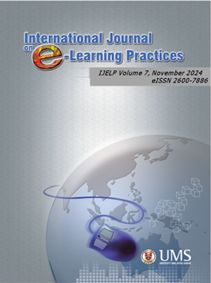THE FIGGERITS APPLICATION FOR MALAYSIAN SECONDARY SCHOOL STUDENTS' VOCABULARY DEVELOPMENT AND MOTIVATION
DOI:
https://doi.org/10.51200/ijelp.v7i1.5445Keywords:
vocabulary, motivation, secondary school, ESL classroom, DGBLL, ZPD, socio-constructivist theoryAbstract
This study examines the influence of Figgerits on vocabulary enhancement and student motivation in a secondary school in Sabah, Malaysia. The study centres around 36 Form 3 Alnair students with different English proficiency levels. Its objective is to explore students’ perceptions and experiences on the impact of Figgerits in an ESL classroom. The study used qualitative methods through semi-structured interviews. The findings indicate that students perceive Figgerits to substantially improve their vocabulary acquisition and classroom engagement. The study highlights the significance of integrating digital game-based language learning (DGBLL) with educational theories like Vygotsky's socio-constructivist theory and the Zone of Proximal Development to guarantee accuracy and dependability. Although there are limitations due to technology, the application promotes a cooperative and inspiring atmosphere for learning. The challenges that have been recognised include the need to address technology accessibility and to maintain a balanced level of difficulty to preserve student motivation. Future research should prioritise more significant sample numbers, longitudinal investigations, and the investigation of adaptive learning systems. This study offers valuable insights into the incorporation of gamified learning technologies in ESL instruction, highlighting their capacity to enhance language learning results and student motivation.
Keywords: vocabulary, motivation, ESL classroom, digital game-based language learning (DGBLL).
References
Ali, M., & Bakar, R. (2023). Perceptions of engagement and enjoyment using digital game-based language learning in ESL classrooms. Journal of Digital Learning and Education, 27(1), 112-126.
Alqahtani, M. (2015). The importance of vocabulary in language learning and how to be taught. International journal of teaching and education, 3(3), 21-34.
Bakhsh, S. A. (2016). Using games as a tool in teaching vocabulary to young learners. English language teaching, 9(7), 120-128.
Beck, I. L., McKeown, M. G., & Kucan, L. (2002). Bringing words to life: Robust vocabulary instruction. Guilford Press. https://eric.ed.gov/?redir=https%3a%2f%2fwww.guilford.com%2fbooks%2fBringing-Words-to-Life%2fBeck-McKeown-Kucan%2f9781462508167
Calvo‐Ferrer, J. R. (2017). Educational games as stand‐ alone learning tools and their motivational effect on L 2 vocabulary acquisition and perceived learning gains. British Journal of Educational Technology, 48(2), 264-278
Chen, C. M., Hsu, Y. S., & Kinshuk. (2015). Effects of competitive digital game-based learning on students’ achievement and attitude in geometry learning: A case of educational game design. Computers & Education, 81, 49–58. https://doi.org/10.1016/j.compedu.2014.09.002
Chen, L., & Wong, K. (2022). Digital game-based language learning: Vocabulary acquisition and practical application. Language Learning & Technology, 26(1), 22-36.
Chik, A. (2019). Mobile-assisted language learning: A review of empirical research from 2016 to 2018. Journal of Computer Assisted Learning, 35(3), 263–276. https://doi.org/10.1111/jcal.12330
Deci, E. L., & Ryan, R. M. (1985). Intrinsic motivation and self-determination in human behavior. Plenum. http://dx.doi.org/10.1007/978-1-4899-2271-7
Gardner, R. C. (2001). Integrative motivation: Past, present, and future. In Z. Dörnyei & R. Schmidt (Eds.), Motivation and second language acquisition (pp. 43–70). University of Western Ontario. https://publish.uwo.ca/~gardner/docs/GardnerPublicLecture1.pdf
Hassan, R., & Ismail, A. (2023). Gamified Mobile-Assisted Language Learning Tools: A Study of Malaysian Secondary School Students. Journal of Digital Learning in Education, 28(1), 145-160.
Hattie, J. (2009). Visible learning: A synthesis of over 800 meta-analyses relating to achievement. Routledge. https://apprendre.auf.org/wp-content/opera/13-BF-References-et-biblio-RPT-2014/Visible%20Learning_A%20synthesis%20or%20over%20800%20Meta-analyses%20Relating%20to%20Achievement_Hattie%20J%202009%20...pdf
Kapp, K. M. (2012). What is gamification. The gamification of learning and instruction: game-based methods and strategies for training and education, 1-23.
Kaur, P., & Singh, R. (2022). Students' recommendations for gamification in ESL classrooms. International Journal of Language Education Technology, 16(4), 56-70.
Mayer, R. E. (2015). On the need for research evidence to guide the design of computer games for learning. Educational psychologist, 50(4), 349-353.
McGonigal, J. (2013). Reality is broken: Why games make us better and how they can change the world. New York, NY: Penguin
Puentedura, R. R. (2014). SAMR: A model for enhancing technology integration in the classroom. https://www.hippasus.com/rrpweblog/archives/2014/10/02/SAMRABriefIntroduction.pdf
Rankin, Y. (2002). A brief historical overview of computer-assisted language learning. CALICO Journal, 20(2), 279–286. https://www.jstor.org/stable/24147920
Rashid, S., & Aziz, A. (2021). Assessing the impact of a gamified vocabulary learning platform on secondary school students. Journal of Interactive Learning Research, 32 (4), 465-483.
Sung, Y. T., & Chang, K. E. (2015). Digital game-based learning in different educational levels: A case study with a math game. Computers & Education, 89, 133–141. https://doi.org/10.1016/j.compedu.2015.08.001
Tan, S. H., & Wong, J. Y. (2020). Student perspectives on digital game-based learning for language acquisition. Journal of Interactive Learning Research, 31(1), 54-67.
Vygotsky, L. S. (1978). Mind in society: The development of higher psychological processes. Massachusetts: Harvard University Press.
Yudintseva, A. (2015). Game-enhanced second language vocabulary acquisition strategies: A systematic review. Open Journal of Social Sciences, 3(10), 101.
Zainal, A., & Hashim, H. (2021). Gamification and Mobile Apps in Malaysian Secondary Schools: Enhancing Motivation and Learning Outcomes. International Journal of Language Education and Technology, 17(2), 89-104.






